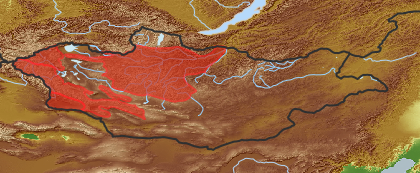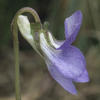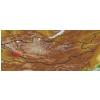| Class: | angiosperms |
| Order: | Dipsacales |
| Family: | Valerianaceae |
| Genus: | Patrinia |
| Scientific name: | Patrinia intermedia (Hornem.) Roem. et Schult. |
| Name acc. to: | Gubanov 1996 |
| Link to Flora of China: | http://www.efloras.org/browse.aspx?flora_id=2&name_str=Patrinia+intermedia |
| open map in a new window |  |
| Habitat: | Brook banks, shrubberies, rocks, steppe slopes of mountains and hills (Grubov 2001). |
| Habit (i)general appearance of a plant | |
| Growth form: (i)Herb, shrub, tree or climber. | herb (i)Herbaceous, erect plant, up to 2m high, mostly with a leafy shoot; if perennial, shoots die to the ground each season, shoots are not woody
example: Artemisia pectinata   inherited by family Valerianaceae: herb inherited by family Valerianaceae: herb
|
| Parasite status: (i)Is the plant a half- or full parasite? | no parasite/saprophyte (i)Plant fully autonomous, leaves with chlorophyll
example: Most plants, Ranunculus  inherited by family Valerianaceae: no parasite/saprophyte inherited by family Valerianaceae: no parasite/saprophyte
|
| Leaf (i)expanded, usually photosynthetic organ of a plant (including phylloclades) | |
| Leaf arrangement: (i)Arrangement of leaves at the stem. | opposite, opposite-decussate (i)Two leaves per node
example: Lamiaceae, e.g. Phlomis    inherited by family Valerianaceae: opposite, opposite-decussate inherited by family Valerianaceae: opposite, opposite-decussate
|
| Leaf veination: (i)Arrangement of the main veins of a leaf. | pinnate (i)One main vein, several side veins, sometimes inconspicuous
example: Cicerbita     inherited by family Valerianaceae: pinnate inherited by family Valerianaceae: pinnate
|
| Flower (i)reproductive portion of the plant, consisting of sepals, petals, stamens, and pistils | |
| Flower appearance and pollination: (i)General appearance of the flower. | attractive, animal-pollinated (i)attractive and coloured flowers, mostly large, attracting surely animals
example: Trollius, Rosa, Chamaerhodos  inherited by family Valerianaceae: attractive, animal-pollinated inherited by family Valerianaceae: attractive, animal-pollinated
|
| Flower colour: (i)Attention: assess colour of the most colourful parts of the flower, but not of the stamens; be aware of single plants with a mutation (mostly white) on flower colour. | white (i)Most plants of the population white
example: Pleurospermum, Maianthemum  inherited by family Valerianaceae: white inherited by family Valerianaceae: white
yellow to orange (i)Pale to golden yellow
example: Ranunculus, Crepis  inherited by family Valerianaceae: yellow to orange inherited by family Valerianaceae: yellow to orange  inherited by genus Patrinia: yellow to orange inherited by genus Patrinia: yellow to orange
purple to violet (i)All colors between purple and violet, often changing with flower age
example: Pulmonaria  inherited by family Valerianaceae: purple to violet inherited by family Valerianaceae: purple to violet
|
| Perianth arrangement: (i)Attention: in some plants, flowers may be dimorphic in different ways (dioecious or gynodioecious). If flowers vary, record the characters of the most showy flowers. | double, different (i)Two types of perianth leaves, differently coloured (sepals: outer periant leaves, usually greenish, and petals: inner perianth leaves, usually coloured)
example: Parnassia    inherited by family Valerianaceae: double, different inherited by family Valerianaceae: double, different
|
| Diameter of flower: (i)Diameter of flower or flower head. | from 10 mm to 20 mm (i)
example: Potentilla  inherited by family Valerianaceae: inherited by family Valerianaceae:
|
| Flower symmetry: (i)Symmetry of the perianth leaves. Attention: to assess this character, look on sepals, petals and stamens, but neglect carpels and ovary. | radiary, regular (actinomorphic) (i)More than two axis of symmetry
example: Saxifraga: 5; Iris: 3   inherited by family Valerianaceae: radiary, regular (actinomorphic) inherited by family Valerianaceae: radiary, regular (actinomorphic)
zygomorphic (i)One axis of symmetry, monosymmetrical flowers
example: Pedicularis, Nepeta, Viola     inherited by family Valerianaceae: zygomorphic inherited by family Valerianaceae: zygomorphic
|
| Flower form: (i)common forms of flowers ? Veronica | tubular to funnel-shaped (i)Petals form a tube, are often partially united to a cylindrical corolla, often surrounded by a calyx   inherited by family Valerianaceae: tubular to funnel-shaped inherited by family Valerianaceae: tubular to funnel-shaped
campanulate (i)Petals united to a bell-shaped corolla   inherited by genus Patrinia: campanulate inherited by genus Patrinia: campanulate
|
| Sepal number: (i)Number of sepal leaves (outer perianth leaves, calyx leaves, mostly greenish). Attention, this character applies only for flowers separated in sepals and petals, thus excluding most monocots. Be aware of the bracts (involucral leaves) of Asteraceae flowerheads, do not qualify these as sepals! Be also aware in Rosaceae is often an epicalyx developed, in this case count all parts. | none or rudimentary (i)Hardly visible or absent, since perianth uniform
example: All monocots with uniform perianth, many Asteraceae and Apiaceae  inherited by family Valerianaceae: none or rudimentary inherited by family Valerianaceae: none or rudimentary
|
| Petal / Tepal fusion: (i)To which degree are the petal leaves connected? Petals sympetalous. | fused (i)petal leaves united, only tips are free (gamopetalous, sympetalous)
example: Linnaea, Adenophora, Stellera  inherited by family Valerianaceae: fused inherited by family Valerianaceae: fused
|
| Spur: (i)A hollow, slender, sac-like appendage of the perianth leaves, storing nectar. | no spur (i)Flower without appendage
example: Peganum  inherited by family Valerianaceae: no spur inherited by family Valerianaceae: no spur
one (i)One leaf with a spur
example: Linaria, Delphinium    inherited by family Valerianaceae: one inherited by family Valerianaceae: one
|
| Stamen number: (i)Attention: We ask for the reproductive organs of the flower dispersing pollen. Count only fully fertile stamens, not staminodia (e.g. Parnassia). | 3 (i)
example: Poa, Iris  inherited by family Valerianaceae: 3 inherited by family Valerianaceae: 3
4 (i)Extremely rare, may be absent
example: Plantago  inherited by family Valerianaceae: 4 inherited by family Valerianaceae: 4  inherited by genus Patrinia: 4 inherited by genus Patrinia: 4
|
| Carpel fusion: (i)To which degree are the carpels (modified leaf forming simple pistil or part of a compound pistil) fused. | fused (i)Carpels united into an ovary, only styles are free
example: Malus, Berberis  inherited by family Valerianaceae: fused inherited by family Valerianaceae: fused
|
| Style number: (i)Portion of the pistil connecting the stigma to the ovary. | 1  inherited by family Valerianaceae: 1 inherited by family Valerianaceae: 1
|
| Ovary position: (i)For entirely or partly fused carpels, describe their position in relation to the insertion point of perianth leaves (best done by doing a longitudinal section of a flower). | inferior (i)Ovary below the point where perianth leaves are inserted, always fused to an ovary
example: Vaccinum    inherited by family Valerianaceae: inferior inherited by family Valerianaceae: inferior
|
| Fruit (i)the seed bearing organ, with or without adnate parts; a ripened ovary and any other structures which are attached and ripen with it. Aggregate fruits are handled like simple fruits for determination. | |
| Type of fruit: (i)Common fruit types (including pseudocarp). | Indehiscent fruits  inherited by family Valerianaceae: Indehiscent fruits inherited by family Valerianaceae: Indehiscent fruits
achene (i)A small, dry, indehiscent fruit with a single seed
example: Asteraceae, Apiaceae (schizocarp), Dipsacaceae, Rosaceae, Ranunculaceae    inherited by family Valerianaceae: achene inherited by family Valerianaceae: achene
nut or nutlet (i)Dry fruit with a single, hard stone inside (and usually a large often edible embryo)   inherited by family Valerianaceae: nut or nutlet inherited by family Valerianaceae: nut or nutlet
|
| Root / shoot below ground (i)plant part below ground (in most cases), including below ground shoots, without leaves | |
| Root type: (i)Organisation of the roots. | allorhizous (i)Plant with a conspicuous tap root, one larger tap root with side roots
example: Dicotyledonae  inherited by order Dipsacales: allorhizous inherited by order Dipsacales: allorhizous
|
| Distribution (i)region where the plant is likely to be found | |
| Distribution (Veg. Zones): (i)acc. to Grubov 1952 | Khangai (i)In distribution data often named as '3' 
Khobdo (i)In distribution data often named as '6' 
Mongolian Altai (i)In distribution data often named as '7' 
Dzungarian Gobi (i)In distribution data often named as '14' 
acc. to: Gubanov 1996 |
| Distribution Khangay: (i)acc. Flora Khangaya 1989 | II
|